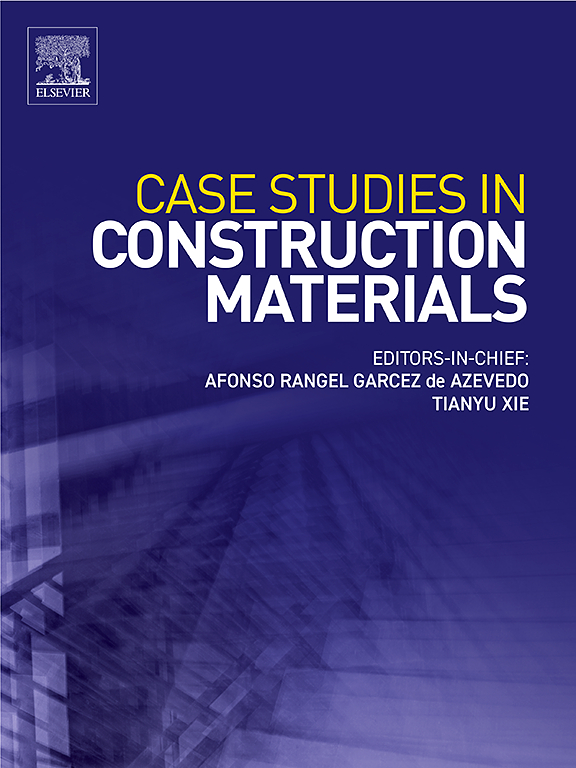Hybrid fiber-reinforced geopolymer composites with enhanced impact resistance for marine structures
IF 6.6
2区 工程技术
Q1 CONSTRUCTION & BUILDING TECHNOLOGY
引用次数: 0
Abstract
To address the growing demands for corrosion-resistant marine infrastructure in chloride-rich environments, the mechanical properties and damage mechanisms of engineered geopolymer composites (EGC) reinforced with polyvinyl alcohol (PVA) fiber blends and polyethylene (PE) fiber blends under low-velocity impact were investigated in this study. By preparing EGC specimens reinforced with PVA/PE fiber blends with different volume doping (0–2 %), uniaxial tensile, compressive and low-velocity impact experiments were carried out to analyze the effects of fiber blending ratios on the material properties. The results showed that the PVA fibers enhanced the interfacial bonding through hydroxyl bonding, which significantly increased the tensile and compressive strengths of the materials, while the PE fibers exhibited excellent crack control and energy dissipation ability under impact loading due to their high specific surface area and hydrophobicity. During pseudo-static loading, the crack control ability of PVA fiber specimens was better than that of PE fiber specimens; however, PE fiber specimens were able to form a more homogeneous microcrack network under low-velocity impact. The PE/PVA fiber hybrid system (EGC-0.5–1.5) has comprehensive advantages in tensile ductility (7.86 %) and tensile strength (3.85 MPa), making it suitable for high impact demand scenarios. The pure PVA fiber hybrid system (EGC-2–0) can control the tensile crack width to around 39 μ m, while reducing the cost by 14–39 % compared to the PE fiber system. It is suitable for engineering scenarios that require strict crack control and economic considerations.
海洋结构用增强抗冲击的混杂纤维增强地聚合物复合材料
为了满足海洋基础设施在富氯环境中日益增长的耐腐蚀需求,研究了聚乙烯醇(PVA)纤维和聚乙烯(PE)纤维共混增强工程地聚合物复合材料(EGC)在低速冲击下的力学性能和损伤机理。通过制备不同掺量(0-2 %)的PVA/PE共混纤维增强EGC试样,进行单轴拉伸、压缩和低速冲击试验,分析纤维掺量对材料性能的影响。结果表明,PVA纤维通过羟基键合增强了界面键合,显著提高了材料的抗拉和抗压强度,而PE纤维由于具有较高的比表面积和疏水性,在冲击载荷下表现出优异的裂缝控制和能量耗散能力。在拟静力加载过程中,PVA纤维试件的裂缝控制能力优于PE纤维试件;而PE纤维试样在低速冲击下能够形成更为均匀的微裂纹网络。PE/PVA纤维混合体系(EGC-0.5-1.5)在拉伸延展性(7.86 %)和拉伸强度(3.85 MPa)方面具有综合优势,适用于高冲击需求场景。纯PVA纤维混合体系(EGC-2-0)可将拉伸裂纹宽度控制在39 μ m左右,与PE纤维体系相比,成本降低14 - 39% %。适用于对裂缝控制要求严格和经济考虑的工程场景。
本文章由计算机程序翻译,如有差异,请以英文原文为准。
求助全文
约1分钟内获得全文
求助全文
来源期刊

Case Studies in Construction Materials
Multiple-
CiteScore
7.60
自引率
19.40%
发文量
842
审稿时长
63 days
期刊介绍:
Case Studies in Construction Materials provides a forum for the rapid publication of short, structured Case Studies on construction materials. In addition, the journal also publishes related Short Communications, Full length research article and Comprehensive review papers (by invitation).
The journal will provide an essential compendium of case studies for practicing engineers, designers, researchers and other practitioners who are interested in all aspects construction materials. The journal will publish new and novel case studies, but will also provide a forum for the publication of high quality descriptions of classic construction material problems and solutions.
 求助内容:
求助内容: 应助结果提醒方式:
应助结果提醒方式:


